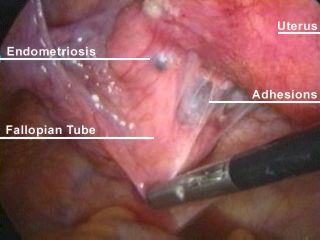Endometriosis more common in lean women: study
Heavy women are less likely to be diagnosed with endometriosis than their slimmer peers, according to a new study.
Researchers following more than 116,000 women found that morbidly obese study participants were 39 percent less likely than normal-weight women to develop the chronic condition - in which uterine tissue grows outside the uterus and causes painful periods and bleeding.
That link was especially strong among women with infertility, according to Dr. Divya Shah from the University of Iowa Hospitals and Clinics in Iowa City and her colleagues.
Still, Shah told Reuters Health the findings don’t prove that carrying around extra pounds protects against endometriosis, which affects more than 5 million women and teen girls in the U.S.
“By no means would I suggest ever that someone gain weight to try to reduce the risk of endometriosis,” she said.
Shah and her colleagues used data from a long-term study of female nurses who were tracked beginning in 1989, when they were 25 to 42 years old. Women reported their height and weight as 18-year-olds and updated researchers on their weight and any new medical diagnoses every two years.
Between 1989 and 2011, about 5,500 of them were diagnosed with endometriosis.
 The researchers found both current weight and weight at age 18 were tied to a woman’s risk of endometriosis - so that the heavier she was, the lower her chance of being diagnosed with the condition.
The researchers found both current weight and weight at age 18 were tied to a woman’s risk of endometriosis - so that the heavier she was, the lower her chance of being diagnosed with the condition.
Among those with fertility problems, in particular, women with a body mass index (BMI) of 40 or above were 62 percent less likely to develop endometriosis than women on the low end of the normal BMI range, the study team wrote in Human Reproduction.
A five-foot, six-inch woman weighing 248 pounds has a BMI of 40, which qualifies as morbidly obese. At the same height, a woman between 118 lbs and 150 lbs would be considered normal weight.
Women with infertility tend to have higher rates of other hormonal conditions, Shah said - which may explain the especially strong weight association in that group.
For example, polycystic ovary syndrome (PCOS) is one cause of infertility, and women with PCOS are often overweight and don’t typically get endometriosis. So (statistically) that may skew the likelihood of endometriosis in infertile women toward the lower end of the weight spectrum, she said.
Dr. Steven Young, who has studied and treated endometriosis at the University of North Carolina at Chapel Hill, said that many studies - and his own clinical experience - suggest the risk is indeed higher in lean women.
“The biggest confusion is, the diagnosis is difficult and (endometriosis) requires surgery for a definitive diagnosis,” said Young, who wasn’t involved in the new research.
Because of that, there could be other factors that affect who has surgery and is diagnosed, he said. Wealthier women may be more likely to have the procedure, for example, and very obese women - who are at higher risk during any surgery - less likely.
Another possibility is that symptoms of endometriosis start early, leading young women to change their eating habits, and the diagnosis comes much later.
“Women with endometriosis may be less prone to eating; they may feel sick,” Young told Reuters Health.
Shah said it often takes a decade or longer for women to be diagnosed once they start having period pain.
The researchers agreed there are still many questions about what could explain the link between weight and endometriosis, especially among women without fertility problems.
For now, Shah said, knowing that association may help researchers looking for the underlying causes of endometriosis and may make doctors more likely to suspect endometriosis in lean women with period pain.
SOURCE: Human Reproduction, online May 14, 2013.
###
Body size and endometriosis: results from 20 years of follow-up within the Nurses’ Health Study II prospective cohort
WIDER IMPLICATIONS OF THE STUDY The results of this study suggest that endometriosis is inversely associated with early adult BMI and may correlate with a peripheral body fat distribution.
STUDY FUNDING/COMPETING INTEREST This study was supported by research grants HD48544 and HD52473 and HD57210 from the Eunice Kennedy Shriver National Institute of Child Health and Human Development. The Nurses’ Health Study II is supported by the Public Health Service grant CA50385 from the National Cancer Institute, NIH, U.S. Department of Health and Human Services. None of the authors has a conflict of interest to disclose.
Divya K. Shah,
Katharine F. Correia,
Allison F. Vitonis and
Stacey A. Missmer